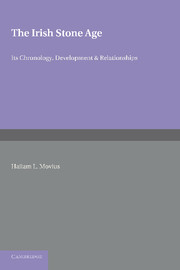Book contents
- Frontmatter
- Dedication
- Contents
- ILLUSTRATIONS
- FOREWORD
- PREFACE
- INTRODUCTION
- Part One THE CHRONOLOGY OF THE LATE-GLACIAL AND EARLY POST-GLACIAL PERIODS IN NORTHERN AND WESTERN EUROPE
- Part Two THE STONE AGE CULTURES OF IRELAND
- CHAPTER I The Antiquity of Man in Ireland
- CHAPTER II The Mesolithic Culture of the Irish Raised Beaches
- CHAPTER III The Origin and Affinities of the Larnian Culture
- CHAPTER IV Post-Larnian Developments
- CHAPTER V Conclusions
- Appendices I-VI
- REFERENCES CITED IN THE TEXT
- CLASSIFIED LIST OF REFERENCES TO CAVE RESEARCH AND STONE AGE ARCHAEOLOGY IN IRELAND
- ADDENDUM
- INDEX
CHAPTER V - Conclusions
from Part Two - THE STONE AGE CULTURES OF IRELAND
Published online by Cambridge University Press: 05 June 2016
- Frontmatter
- Dedication
- Contents
- ILLUSTRATIONS
- FOREWORD
- PREFACE
- INTRODUCTION
- Part One THE CHRONOLOGY OF THE LATE-GLACIAL AND EARLY POST-GLACIAL PERIODS IN NORTHERN AND WESTERN EUROPE
- Part Two THE STONE AGE CULTURES OF IRELAND
- CHAPTER I The Antiquity of Man in Ireland
- CHAPTER II The Mesolithic Culture of the Irish Raised Beaches
- CHAPTER III The Origin and Affinities of the Larnian Culture
- CHAPTER IV Post-Larnian Developments
- CHAPTER V Conclusions
- Appendices I-VI
- REFERENCES CITED IN THE TEXT
- CLASSIFIED LIST OF REFERENCES TO CAVE RESEARCH AND STONE AGE ARCHAEOLOGY IN IRELAND
- ADDENDUM
- INDEX
Summary
Throughout Part II of this book an attempt has been made to show that the Stone Age cultures of Ireland can be neither correctly interpreted nor properly understood except in terms of the natural surroundings to which they were adapted. It seems evident that the prehistorian can no longer deal in the abstract with humanity and fail to connect material culture traits with the environment in which they were produced. As Tallgren has stated (1937, p. 159), culture must be regarded as a product of man and not of nature. It is only when the sum total of the evidence is examined and synthesized that it is possible to offer an interpretation, since cultures, whether prehistoric or modern, cannot be dealt with as dead groups of fossils but must be treated as living functioning organisms. In other words, the archaeologist must regard traits functionally and not fall into the pitfall of the typologist, who observes them as isolated abstractions. An attempt should be made to demonstrate why tools were evolved, what they were used for, whether and how they were hafted, and to study them collectively, not only from a typological viewpoint, but also as artifacts made by man to assist him in his control over nature. By employing this approach Stone Age archaeology takes on a new and more comprehensive character, and falls in with the human sciences, disassociating itself from the more definitely subjective approach of the taxonomic disciplines. Research into various fields covered by the natural sciences whether taxonomic or not is, however, essential for the establishment of prehistoric cultures in their proper chronological perspective, and for providing the data for a reconstruction of the natural conditions pertaining at a given period. Nevertheless, for synthesizing this material and bringing the net results to bear on the problem of man's development archaeology stands alone.
In order to reconstruct the environment of early Ireland, it was necessary at the outset of Part I to review the evidence from Northern Europe, where the study of prehistory began over a century ago, and where a synthesis of scientific method has been brought to bear on archaeology, which has profoundly altered field technique.
- Type
- Chapter
- Information
- The Irish Stone AgeIts Chronology, Development and Relationships, pp. 257 - 262Publisher: Cambridge University PressPrint publication year: 2013



